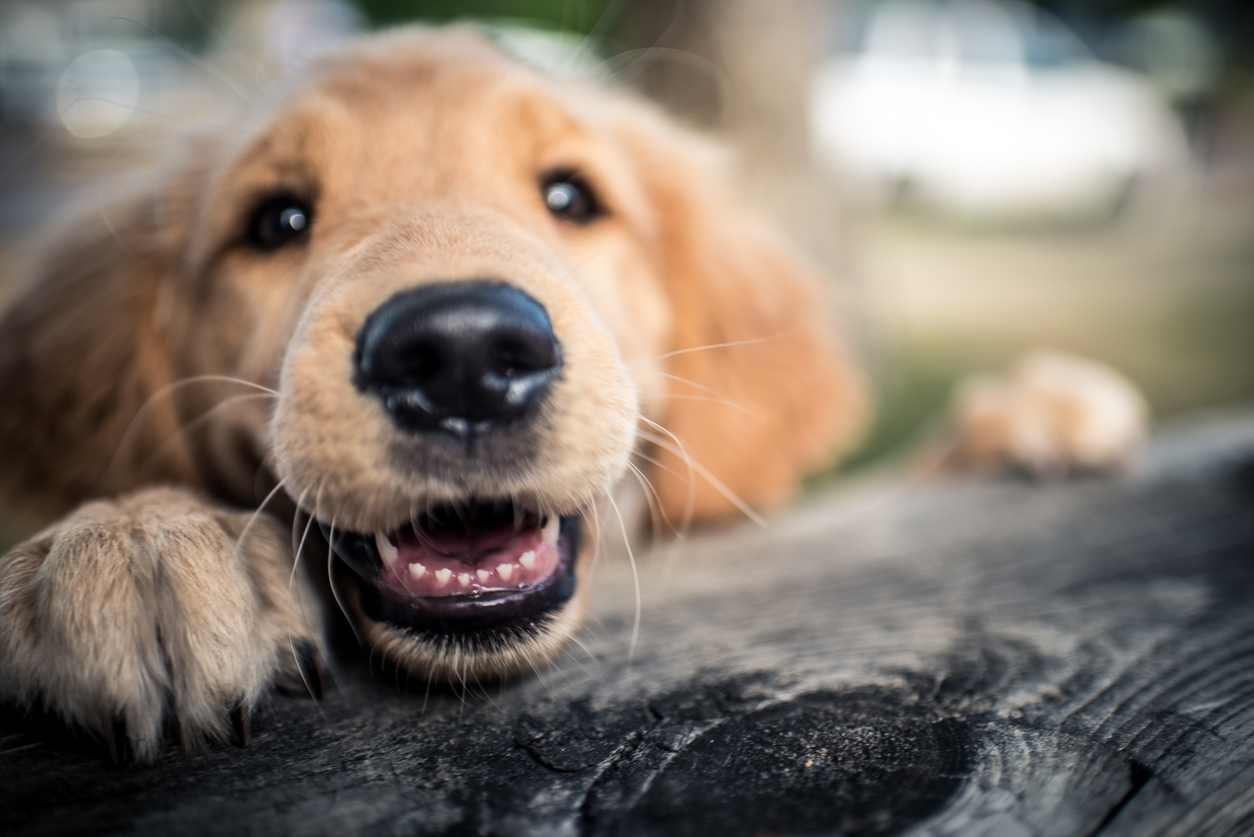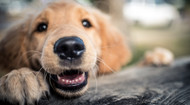
Chances are you’ve never thought about your dog’s whiskers. However, many dog lovers have long debated the age-old question: To trim, or not to trim?
Whiskers typically appear bilaterally on the muzzle of the face, on the chin, and in the corners of the eyebrows. These hairs differ from the hair of the coat in many ways. Known as vibrissae, these coarse, wiry hairs are thicker and longer than regular hair, and they usually stand out with black coloring that will turn white with age. These vibrissae are known for their thick roots, which can grow three times deeper than the roots of regular hairs.
Do whiskers serve a purpose?
Male humans shave their “whiskers” daily without reporting any loss of senses or abilities. Cats, on the other hand, use their whiskers as sort of a sixth sense. They brush their whiskers against objects they encounter to get a sense of their space. Cat whiskers deliver messages to the brain that identify locations, sizes, and textures of objects. Whiskers can even guide cats in the dark. Whiskers can also feel air currents, which help cats detect approaching animals and wind directions.
Dogs can use their whiskers to learn more about the world around them, too. However, they do not depend on whisker messages the way cats do. Whiskers can help dogs during outings in the field, but most dogs do not rely on their whiskers to get through everyday activities.
Trimming Whiskers
Most dogs will live their lives with their whiskers in tact, but certain breeds may have them trimmed at the groomer. If your dog has a fuzzy face, you may find that the hair on the muzzle can become a problem. Food can dirty the pretty face of a poodle, schnauzer, or other hairy-faced breed. The hair on the muzzle and below the bottom jaw can become encrusted with remnants of dinner scraps and worsened by water that spreads a mess down the dog’s face, tangling the hair on the chin and in the beard.
Groomers often clip the hair on the muzzles of longhaired dogs, removing the possibility of food trapping and smelling. This helps keep the face clean and helps prevent bacteria from forming in the hair. You can use hair clippers or scissors to remove whiskers, but the whiskers should never be plucked, as that process can be very painful.
About Trimmed Whiskers
It’s hard to measure the effects trimming dogs’ whiskers, as they can’t tell us how it makes them feel. Some hypothesize that trimming a dog’s whiskers diminishes his or her ability to navigate or “feel” the presence of intruders. However, most pet owners report no behavioral changes in their pets after trimming. There is no observable exhibition of pain, disorientation, or confusion. So, don’t worry if your groomer removes these hairs.
Dog breeders commonly remove the whiskers when showing their dogs in dog shows. They believe that removing the unruly hairs is part of regular grooming. The “clean” look gives the dogs an improved profile and avoids distracting the judges. Most breeds are not specifically penalized for having whiskers, except for breeds like poodles, whose breed standard describes grooming the muzzle.
Talk to your veterinarian if you have questions about the whisker anatomy, and be sure to discuss the matter with your groomer if you have a preference.
 Chances are you’ve never thought about your dog’s whiskers. However, many dog lovers have long debated the age-old question: To trim, or not to trim?
Whiskers typically appear bilaterally on the muzzle of the face, on the chin, and in the corners of the eyebrows. These hairs differ from the hair of the coat in many ways. Known as vibrissae, these coarse, wiry hairs are thicker and longer than regular hair, and they usually stand out with black coloring that will turn white with age. These vibrissae are known for their thick roots, which can grow three times deeper than the roots of regular hairs.
Do whiskers serve a purpose?
Male humans shave their “whiskers” daily without reporting any loss of senses or abilities. Cats, on the other hand, use their whiskers as sort of a sixth sense. They brush their whiskers against objects they encounter to get a sense of their space. Cat whiskers deliver messages to the brain that identify locations, sizes, and textures of objects. Whiskers can even guide cats in the dark. Whiskers can also feel air currents, which help cats detect approaching animals and wind directions.
Dogs can use their whiskers to learn more about the world around them, too. However, they do not depend on whisker messages the way cats do. Whiskers can help dogs during outings in the field, but most dogs do not rely on their whiskers to get through everyday activities.
Trimming Whiskers
Most dogs will live their lives with their whiskers in tact, but certain breeds may have them trimmed at the groomer. If your dog has a fuzzy face, you may find that the hair on the muzzle can become a problem. Food can dirty the pretty face of a poodle, schnauzer, or other hairy-faced breed. The hair on the muzzle and below the bottom jaw can become encrusted with remnants of dinner scraps and worsened by water that spreads a mess down the dog’s face, tangling the hair on the chin and in the beard.
Groomers often clip the hair on the muzzles of longhaired dogs, removing the possibility of food trapping and smelling. This helps keep the face clean and helps prevent bacteria from forming in the hair. You can use hair clippers or scissors to remove whiskers, but the whiskers should never be plucked, as that process can be very painful.
About Trimmed Whiskers
It’s hard to measure the effects trimming dogs’ whiskers, as they can’t tell us how it makes them feel. Some hypothesize that trimming a dog’s whiskers diminishes his or her ability to navigate or “feel” the presence of intruders. However, most pet owners report no behavioral changes in their pets after trimming. There is no observable exhibition of pain, disorientation, or confusion. So, don’t worry if your groomer removes these hairs.
Dog breeders commonly remove the whiskers when showing their dogs in dog shows. They believe that removing the unruly hairs is part of regular grooming. The “clean” look gives the dogs an improved profile and avoids distracting the judges. Most breeds are not specifically penalized for having whiskers, except for breeds like poodles, whose breed standard describes grooming the muzzle.
Talk to your veterinarian if you have questions about the whisker anatomy, and be sure to discuss the matter with your groomer if you have a preference.
Chances are you’ve never thought about your dog’s whiskers. However, many dog lovers have long debated the age-old question: To trim, or not to trim?
Whiskers typically appear bilaterally on the muzzle of the face, on the chin, and in the corners of the eyebrows. These hairs differ from the hair of the coat in many ways. Known as vibrissae, these coarse, wiry hairs are thicker and longer than regular hair, and they usually stand out with black coloring that will turn white with age. These vibrissae are known for their thick roots, which can grow three times deeper than the roots of regular hairs.
Do whiskers serve a purpose?
Male humans shave their “whiskers” daily without reporting any loss of senses or abilities. Cats, on the other hand, use their whiskers as sort of a sixth sense. They brush their whiskers against objects they encounter to get a sense of their space. Cat whiskers deliver messages to the brain that identify locations, sizes, and textures of objects. Whiskers can even guide cats in the dark. Whiskers can also feel air currents, which help cats detect approaching animals and wind directions.
Dogs can use their whiskers to learn more about the world around them, too. However, they do not depend on whisker messages the way cats do. Whiskers can help dogs during outings in the field, but most dogs do not rely on their whiskers to get through everyday activities.
Trimming Whiskers
Most dogs will live their lives with their whiskers in tact, but certain breeds may have them trimmed at the groomer. If your dog has a fuzzy face, you may find that the hair on the muzzle can become a problem. Food can dirty the pretty face of a poodle, schnauzer, or other hairy-faced breed. The hair on the muzzle and below the bottom jaw can become encrusted with remnants of dinner scraps and worsened by water that spreads a mess down the dog’s face, tangling the hair on the chin and in the beard.
Groomers often clip the hair on the muzzles of longhaired dogs, removing the possibility of food trapping and smelling. This helps keep the face clean and helps prevent bacteria from forming in the hair. You can use hair clippers or scissors to remove whiskers, but the whiskers should never be plucked, as that process can be very painful.
About Trimmed Whiskers
It’s hard to measure the effects trimming dogs’ whiskers, as they can’t tell us how it makes them feel. Some hypothesize that trimming a dog’s whiskers diminishes his or her ability to navigate or “feel” the presence of intruders. However, most pet owners report no behavioral changes in their pets after trimming. There is no observable exhibition of pain, disorientation, or confusion. So, don’t worry if your groomer removes these hairs.
Dog breeders commonly remove the whiskers when showing their dogs in dog shows. They believe that removing the unruly hairs is part of regular grooming. The “clean” look gives the dogs an improved profile and avoids distracting the judges. Most breeds are not specifically penalized for having whiskers, except for breeds like poodles, whose breed standard describes grooming the muzzle.
Talk to your veterinarian if you have questions about the whisker anatomy, and be sure to discuss the matter with your groomer if you have a preference.
